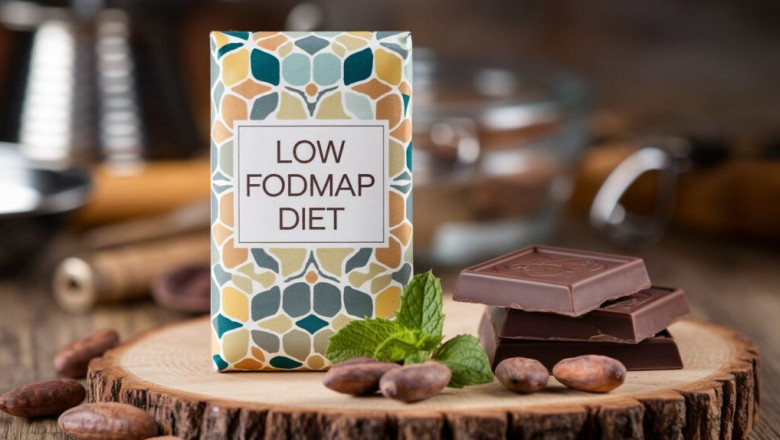views
For many chocolate lovers living with Irritable Bowel Syndrome (IBS), enjoying a sweet treat can feel like walking a digestive tightrope. Chocolate, often seen as an indulgence, can sometimes trigger symptoms due to its content of certain carbohydrates known as FODMAPs. However, following a low FODMAP diet doesn't mean you have to say goodbye to chocolate altogether. With the right knowledge and portion control, chocolate can still be on the menu.
What Is the Low FODMAP Diet?
The low FODMAP diet was developed by researchers at Monash University to help manage symptoms of IBS. FODMAPs are fermentable oligosaccharides, disaccharides, monosaccharides, and polyols – short-chain carbohydrates that are poorly absorbed in the gut and can lead to bloating, gas, cramping, and diarrhea in people with IBS.
A low FODMAP diet reduces the intake of these fermentable carbs, helping to identify which ones trigger symptoms. It’s usually implemented in three phases: elimination, reintroduction, and maintenance.
Is Chocolate Low FODMAP?
Chocolate, like many processed foods, can be a gray area when it comes to FODMAP content. It all depends on the ingredients and portion size. Cocoa, one of the primary ingredients in chocolate, contains fructans and is considered high FODMAP in large amounts. However, in small portions, cocoa and chocolate can be low FODMAP and safe for many people with IBS.
Cocoa and IBS: The Balance Matters
When considering cocoa and IBS, moderation is key. Pure cocoa powder contains fructans, which can trigger IBS symptoms in sensitive individuals if consumed in excess. According to Monash University, up to 2 teaspoons (8 grams) of cocoa powder is considered low FODMAP. Anything above that may cause problems.
For those who want to bake or cook with cocoa, it's important to measure carefully and combine it with other low FODMAP ingredients to stay within safe limits.
Choosing FODMAP Dark Chocolate
Dark chocolate can be a safer option than milk chocolate for those on a low FODMAP diet. That’s because milk chocolate contains lactose, a disaccharide that falls under the FODMAP umbrella and can be particularly troublesome for individuals who are lactose intolerant.
On the other hand, FODMAP dark chocolate contains less sugar and no milk solids, making it lower in FODMAPs when consumed in small portions. The key is to look for dark chocolate with a cocoa content of 70% or higher and check the label for added ingredients like inulin, high fructose corn syrup, or milk powders.
A low FODMAP serving of dark chocolate is typically around 30 grams (1 ounce). This amount allows most people with IBS to enjoy chocolate without triggering symptoms.
Chocolate FODMAP Checklist: What to Look For
If you’re shopping for chocolate while following a low FODMAP diet, here are a few tips to make your selection easier:
Read Ingredient Labels Carefully
Avoid chocolate with high FODMAP ingredients such as high-fructose corn syrup, inulin, chicory root, or milk solids.
Choose Dark Chocolate
As mentioned, FODMAP dark chocolate is typically a safer option. Look for 70% cocoa or higher.
Watch Serving Sizes
Portion control is essential. Even low FODMAP foods can cause symptoms if eaten in large amounts.
Avoid Fillings and Add-ins
Chocolates with caramel, nougat, dried fruits, or cookie pieces are likely to be high FODMAP.
Check for Lactose-Free Options
If you prefer milk chocolate, look for lactose-free or dairy-free alternatives made with rice, almond, or oat milk (in small portions, as oat can also be high FODMAP depending on type and amount).
Low FODMAP Chocolate Brands to Try
Here are a few brands that offer chocolate options more likely to be suitable for those on a low FODMAP diet (always double-check ingredients as formulas can change):
Enjoy Life Foods – Offers dairy-free chocolate chips made with safe ingredients.
Green & Black’s Organic Dark Chocolate – Some varieties with high cocoa content are suitable in small amounts.
Lindt 70% and 85% Cocoa Bars – These contain minimal ingredients and can be low FODMAP in moderation.
Homemade Chocolate Treats
Another great way to control your chocolate intake is by making your own low FODMAP chocolate treats. Here’s a simple idea:
Low FODMAP Chocolate Bark
Melt 100g of dark chocolate (70–85% cocoa)
Add low FODMAP toppings like crushed pecans, shredded coconut, or orange zest
Spread onto a lined baking tray and chill until firm
This treat allows you to enjoy chocolate in a controlled and IBS-friendly way.
Conclusion
Living with IBS doesn’t mean giving up all of your favorite foods. With a little planning, chocolate can still be a part of your low FODMAP lifestyle. Understanding how cocoa and IBS interact, choosing the right type of chocolate, and sticking to appropriate portion sizes are the keys to success.
Whether you’re enjoying a piece of FODMAP dark chocolate after dinner or baking a batch of IBS-friendly brownies, there’s room for indulgence even on a restricted diet. Just remember: when it comes to chocolate FODMAP concerns, less is often more.














Comments
0 comment